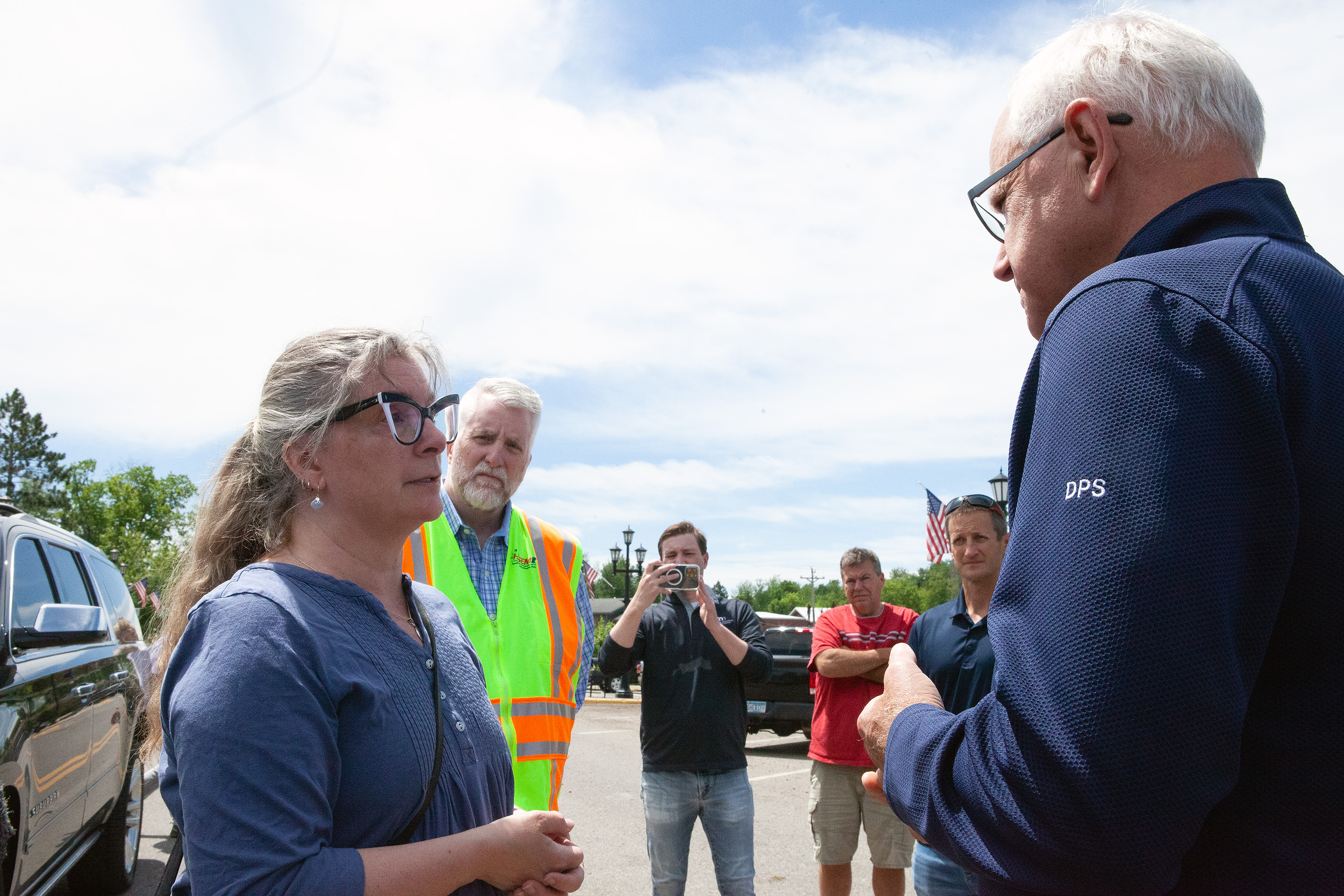
By Jerry Burnes/Iron Range Today
COOK — At the Comet Theater, Ryan Horner walked to the back alley where his wading boots laid in the still-wet grass, he changed into them and crawled through a side window to enter the building.
Further down River Street, Ashley Franks said her business, Franks Pharmacy, took on four feet of water. Kitty corner from there, someone tied a fishing boat to a street light, which now sat on dry ground as some flood water had receded.
Theresa Drift, a local homeless advocate, thought her home was safe when only minor rainwater seeped into the basement — until it wasn’t anymore — and three or four feet of sewage water poured in from her toilets and sinks. Drift and her family were temporarily staying with a friend as of Friday.
“I work with homeless people and now I’m homeless,” Drift told Minnesota Gov. Tim Walz, fighting back tears, as state officials toured one of the hardest hit areas on the Iron Range after several inches of rain deluged the area earlier in the week.
By many definitions, Cook is emblematic of small town America. River Street is lined with family-owned businesses, city hall, a library and several murals of its history and culture. A population of 534 as of the 2020 Census, it’s historically packed a political punch around Minnesota, producing two of the Iron Range’s most influential lawmakers in Tom Bakk and Doug Johnson.
The town hosted its annual Timber Days summer festival in early June. It was a sun-soaked weekend of vendor booths, lawnmower races and a car show. River Street was home to the celebration and parade route through the same downtown corridor that would be impassable 10 days later.
For all its Northwoods beauty and charm, Mayor Harold Johnston told Walz that the original settlers in Cook didn’t have the foresight in 1903 when they built on top of a flood plain near the Little Fork River.
Cook residents more recently battled flood waters in 2018, when several inches of rain washed out areas of the town. Still, its response to a new round of flooding drew questions.
John Jordan, who co-owns The Wash House laundromat, said by the time they realized sandbags were needed from Tuesday’s rain total, there were none. Volunteers packed contractor bags with sand on Thursday, but for many homes and businesses, it was too late.
“We should have been sandbagging on Wednesday,” Drift, the Cook resident, told Walz. She believed the more proactive response would have made a difference. “We had flooding in 2018, we should have known better.”

Business owners along River Street were still assessing the damage as the governor, emergency managers and legislators toured the area.
Horner owns the Comet Theater with his wife, Stephanie. He had not seen the inside for himself until he entered through the side window to see the theater, coffee shop and boutique. Water still engulfed some of the seats.
“I… I didn’t realize how much water there was,” he said, standing in the doorway to the theater portion of the business, experiencing it all for the first time. Later, Horner said the initial look left him mostly speechless. “What am I going to say? I could say we’re going to close the business, but that’s just a reaction.”
A post on the Comet Theater’s Facebook page Saturday morning noted the fire department pumped water out of the seating area and community members helped power wash the seats. They were seeking out dehumidifiers as the cleanup effort started.
The Comet Theater is Minnesota’s longest continuously running single-screen movie theater. Its first showing was the Wizard of Oz in 1939 and the Horners have owned it for about a year. Carol Carlson, the previous owner, was also in downtown Cook on Friday surveying the damage.
“Carol turned it into what it is today — she turned it into a coffee shop and boutique, and more like a destination — it’s her baby,” Horner said. “It’s hard for us and it’s only been a year. For her, it’s going to be really hard.”
Franks, from the local pharmacy, said the business lost about 20 percent of its over-the-counter stock and 10 percent of its prescription drugs. Cook Hospital offered to step in and fill prescriptions for emergency situations, but she had to direct people 30 miles away to Virginia in the interim.
“To the best of my knowledge, everyone is taken care of,” Franks said.
The loss of critical businesses in a small town is not something new for Cook residents. They had to rebound again in 2018 when Zup’s Food Market, the only grocery store within a half hour radius, burned down less than six months after the floods of that year.
Zup’s rebuilt from scratch and reopened in 2020, but local officials and business owners said it’s too early to project a timeline from this year’s floods. Some business owners, Walz said, would face a tough decision on evaluating whether to forge ahead or close down.
At Steve Kajala’s business across River Street from the pharmacy, a woman carried a handful of new mops into the storefront. Kajala is a financial advisor through Prudential, handling people’s retirement, education savings, small businesses and more.
He was able to back a truck up to his business and load all the electronics from inside to save them. Kajala said all the records were saved, but the building sustained significant damage.
“We went electronic this spring,” he said of the record-keeping process. “So I had like two boxes of shred bins that I hauled with me, and that was it.”

Walz expressed optimism that the region would qualify for federal emergency declaration standards that would trigger additional assistance. He also praised the legislators for setting a standard for state emergency funding that would be available.
Federal laws require $10.5 million in damage to public infrastructure across Minnesota and individual counties qualify for funding based on damage thresholds per population. St. Louis County, for example, is enacted at $921,062 in damage, according to a release from U.S. Sen. Amy Klobuchar.
Individual homeowners will have a tougher road ahead. Insurance will cover a portion of flood damage, but not everything when it comes to personal property. Walz said floods are the hardest disasters on people because the insurance won’t make them whole, as opposed to events like tornadoes.
“That’s why I’ve been talking to the commissioners and the legislators — is there something we can do?” Walz told Kajala as they stood next to the flooded roads near his business. “It kills me everytime, because the federal government will come in and say to homeowners that they’ll issue low-interest mortgages or loans. So what, I have two mortgages now?”
“And that’s just to get back to square one,” added State Sen. Grant Hauschild, who represents the Cook area.
For residents like Drift, that process hasn’t even started. She told the governor that water rose to about eight feet in her basement and has since decreased “quite a bit,” but there’s still a lot to fix. She noted her furnace and water heater among the items that might have to come out of pocket.
“I live in a floodplain — I was aware of that when I bought my house, so I have flood insurance — but it’s not going to cover the things I have to fix,” she said to Walz. Her neighbor across the street lost irreplaceable family memorabilia and the one next door could no longer operate her day care business. “Anything you can do for our homes…”
